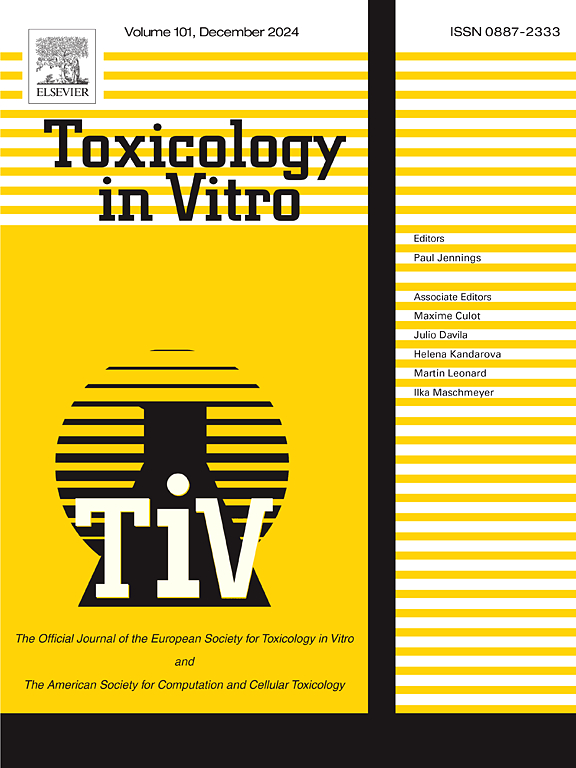6:2 fluorotelomer sulfonate as a safer alternative to PFOS: Comparative cytotoxicity and oxidative stress mechanisms in pancreatic β-cells (INS-1 model)
IF 2.6
3区 医学
Q3 TOXICOLOGY
引用次数: 0
Abstract
Previous studies suggest that 6:2 fluorotelomer sulfonate (6:2 FTSA) exhibits lower hepatotoxicity and reduced reproductive and developmental toxicity compared to perfluorooctane sulfonate (PFOS), indicating it may offer a safer alternative. This study aimed to investigate whether 6:2 FTSA is safer than PFOS in terms of its cytotoxic effects on pancreatic β-cells. Using rat insulinoma cells (INS-1) as a model of pancreatic β-cells, we compared the effects of 6:2 FTSA and PFOS in both their acid (6:2 FTSA-H, PFOS-H) and potassium salt forms (6:2 FTSA-K, PFOS-K) on cell viability through Cell Counting Kit-8 (CCK-8) assays, Trypan Blue staining, and apoptosis assays. Results indicated that 6:2 FTSA was less toxic to INS-1 cells than PFOS (6:2 FTSA-H < PFOS-H; 6:2 FTSA-K < PFOS-K), the LOECs of 6:2 FTSA-H, 6:2 FTSA-K, PFOS-H, and PFOS-K were 150 μM, 150 μM, 20 μM, and 10 μM under FBS free conditions, respectively. To further explore whether these compounds induce cell death via oxidative stress, we measured intracellular reactive oxygen species (ROS) levels, superoxide dismutase (SOD) activity, and malondialdehyde (MDA) levels. All four compounds induced oxidative stress in INS-1 cells, with oxidative stress levels corresponding to cytotoxicity, suggesting β-cell death may occur via an oxidative stress mechanism. In conclusion, this study supports the notion that 6:2 FTSA is a safer alternative to PFOS, particularly regarding risks related to pancreatic β-cell cytotoxic effects. While the in vitro experiments in this study provide valuable preliminary information on the compounds' effects on cells and their mechanisms, they cannot fully capture the complexity of the in vivo environment. Therefore, future research should include in vivo experiments to validate the findings from the in vitro studies and comprehensively evaluate the actual effects of the compounds in living organisms.

6:2氟端聚体磺酸作为全氟辛烷磺酸更安全的替代品:胰腺β细胞的比较细胞毒性和氧化应激机制(INS-1模型)
先前的研究表明,与全氟辛烷磺酸(PFOS)相比,6:2氟端粒磺酸(6:2 FTSA)具有更低的肝毒性和更低的生殖和发育毒性,表明它可能是一种更安全的替代品。本研究旨在探讨6:2 FTSA对胰腺β细胞的细胞毒性作用是否比PFOS更安全。我们以大鼠胰岛素瘤细胞(INS-1)为胰腺β细胞模型,通过细胞计数试剂盒-8 (CCK-8)、台泛蓝染色和凋亡实验,比较了6:2 FTSA和PFOS的酸(6:2 FTSA- h、PFOS- h)和钾盐(6:2 FTSA- k、PFOS- k)对细胞活力的影响。结果表明6:2 FTSA对INS-1细胞的毒性低于PFOS (6:2 FTSA- h <;PFOS-H;6:2 FTSA-K <;无FBS条件下,6:2 FTSA-H、6:2 FTSA-K、PFOS-H和PFOS-K的loec分别为150 μM、150 μM、20 μM和10 μM。为了进一步探索这些化合物是否通过氧化应激诱导细胞死亡,我们测量了细胞内活性氧(ROS)水平、超氧化物歧化酶(SOD)活性和丙二醛(MDA)水平。所有四种化合物均诱导INS-1细胞氧化应激,氧化应激水平与细胞毒性相对应,表明β细胞死亡可能通过氧化应激机制发生。总之,本研究支持6:2 FTSA比全氟辛烷磺酸更安全的观点,特别是考虑到与胰腺β细胞毒性作用相关的风险。虽然本研究中的体外实验为化合物对细胞的作用及其机制提供了有价值的初步信息,但它们不能完全捕捉体内环境的复杂性。因此,未来的研究应包括体内实验,以验证体外研究的结果,并全面评估化合物在生物体中的实际作用。
本文章由计算机程序翻译,如有差异,请以英文原文为准。
求助全文
约1分钟内获得全文
求助全文
来源期刊

Toxicology in Vitro
医学-毒理学
CiteScore
6.50
自引率
3.10%
发文量
181
审稿时长
65 days
期刊介绍:
Toxicology in Vitro publishes original research papers and reviews on the application and use of in vitro systems for assessing or predicting the toxic effects of chemicals and elucidating their mechanisms of action. These in vitro techniques include utilizing cell or tissue cultures, isolated cells, tissue slices, subcellular fractions, transgenic cell cultures, and cells from transgenic organisms, as well as in silico modelling. The Journal will focus on investigations that involve the development and validation of new in vitro methods, e.g. for prediction of toxic effects based on traditional and in silico modelling; on the use of methods in high-throughput toxicology and pharmacology; elucidation of mechanisms of toxic action; the application of genomics, transcriptomics and proteomics in toxicology, as well as on comparative studies that characterise the relationship between in vitro and in vivo findings. The Journal strongly encourages the submission of manuscripts that focus on the development of in vitro methods, their practical applications and regulatory use (e.g. in the areas of food components cosmetics, pharmaceuticals, pesticides, and industrial chemicals). Toxicology in Vitro discourages papers that record reporting on toxicological effects from materials, such as plant extracts or herbal medicines, that have not been chemically characterized.
 求助内容:
求助内容: 应助结果提醒方式:
应助结果提醒方式:


